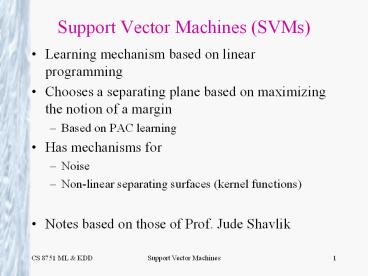Support Vector Machines (SVMs) - PowerPoint PPT Presentation
Title:
Support Vector Machines (SVMs)
Description:
Support Vector Machines (SVMs) Learning mechanism based on linear programming ... See, for example, Chapter 4 of Support Vector Machines by Christianini and Shawe ... – PowerPoint PPT presentation
Number of Views:317
Avg rating:3.0/5.0
Title: Support Vector Machines (SVMs)
1
Support Vector Machines (SVMs)
- Learning mechanism based on linear programming
- Chooses a separating plane based on maximizing
the notion of a margin - Based on PAC learning
- Has mechanisms for
- Noise
- Non-linear separating surfaces (kernel functions)
- Notes based on those of Prof. Jude Shavlik
2
Support Vector Machines
Find the best separating plane in feature space
- many possibilities to choose from
A
A-
3
SVMs The General Idea
- How to pick the best separating plane?
- Idea
- Define a set of inequalities we want to satisfy
- Use advanced optimization methods (e.g., linear
programming) to find satisfying solutions - Key issues
- Dealing with noise
- What if no good linear separating surface?
4
Linear Programming
- Subset of Math Programming
- Problem has the following form
- function f(x1,x2,x3,,xn) to be maximized
- subject to a set of constraints of the form
- g(x1,x2,x3,,xn) gt b
- Math programming - find a set of values for the
variables x1,x2,x3,,xn that meets all of the
constraints and maximizes the function f - Linear programming - solving math programs where
the constraint functions and function to be
maximized use linear combinations of the
variables - Generally easier than general Math Programming
problem - Well studied problem
5
Maximizing the Margin
A
A-
6
PAC Learning
- PAC Probably Approximately Correct learning
- Theorems that can be used to define bounds for
the risk (error) of a family of learning
functions - Basic formula, with probability (1 - ?)
- R risk function, ? is the parameters chosen by
the learner, N is the number of data points, and
h is the VC dimension (something like an estimate
of the complexity of the class of functions)
7
Margins and PAC Learning
- Theorems connect PAC theory to the size of the
margin - Basically, the larger the margin, the better the
expected accuracy - See, for example, Chapter 4 of Support Vector
Machines by Christianini and Shawe-Taylor,
Cambridge University Press, 2002
8
Some Equations
1s result from dividing through by a constant for
convenience
Euclidean length (2 norm) of the weight vector
9
What the Equations Mean
Margin
2 / w2
xw ? 1
A
A-
Support Vectors
xw ? - 1
10
Choosing a Separating Plane
A
A-
?
11
Our Mathematical Program (so far)
for technical reasons easier to optimize this
quadratic program
12
Dealing with Non-Separable Data
- We can add what is called a slack variable to
each example - This variable can be viewed as
- 0 if the example is correctly separated
- y distance we need to move example to make it
- correct (i.e., the distance from its surface)
13
Slack Variables
A
A-
Support Vectors
y
14
The Math Program with Slack Variables
This is the traditional Support Vector Machine
15
Why the word Support?
- All those examples on or on the wrong side of the
two separating planes are the support vectors - Wed get the same answer if we deleted all the
non-support vectors! - i.e., the support vectors examples support
the solution
16
PAC and the Number of Support Vectors
- The fewer the support vectors, the better the
generalization will be - Recall, non-support vectors are
- Correctly classified
- Dont change the learned model if left out of the
training set - So
17
Finding Non-Linear Separating Surfaces
- Map inputs into new space
- Example features x1 x2
- 5 4
- Example features x1 x2 x12 x22
x1x2 - 5 4 25
16 20 - Solve SVM program in this new space
- Computationally complex if many features
- But a clever trick exists
18
The Kernel Trick
- Optimization problems often/always have a
primal and a dual representation - So far weve looked at the primal formulation
- The dual formulation is better for the case of a
non-linear separating surface
19
Perceptrons Re-Visited
20
Dual Form of the Perceptron Learning Rule
21
Primal versus Dual Space
- Primal weight space
- Weight features to make output decision
- Dual training-examples space
- Weight distance (which is based on the features)
to training examples
22
The Dual SVM
23
Non-Zero ais
24
Generalizing the Dot Product
25
The New Space for a Sample Kernel
Our new feature space (with 4 dimensions) - were
doing a dot product in it
26
Visualizing the Kernel
Separating plane (non-linear here but linear in
derived space)
New Space
g(-)
g(-)
g() is feature transformation
function process is similar to what hidden
units do in ANNs but kernel is user chosen
g(-)
g()
g(-)
g(-)
g()
g()
g()
g()
Derived Feature Space
27
More Sample Kernels
28
What Makes a Kernel
29
Key SVM Ideas
- Maximize the margin between positive and negative
examples (connects to PAC theory) - Penalize errors in non-separable case
- Only the support vectors contribute to the
solution - Kernels map examples into a new, usually
non-linear space - We implicitly do dot products in this new space
(in the dual form of the SVM program)































